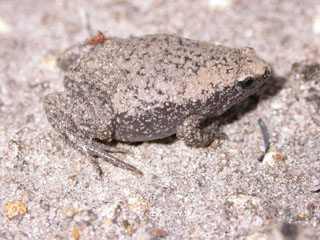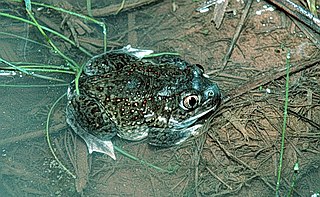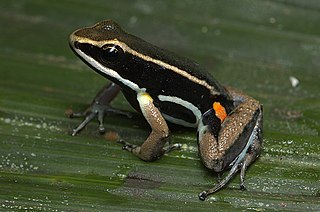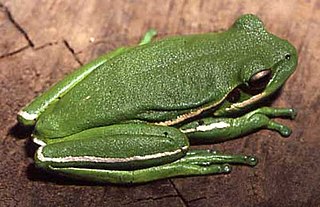
Fletcher's frog, commonly known as the sandpaper frog or black-soled frog, is a species of nocturnal, terrestrial frog native to eastern Australia. It is primarily found in wet sclerophyll forests along mountain ranges and the coast.

Gastrophryne carolinensis, the eastern narrow-mouthed toad, is a species of microhylid frog. It is a relatively small, toad-like amphibian found in damp, shady habitats. The species is highly fossorial, and feeds primarily on ants. These North American microhylids are distinguished from true toads, and other anurans by their moist, smooth skin, their lack of eardrums or tympana, their distinguishable squat body shape, and the unique fold of skin superior to their eyes. It is found in the United States, from southern Maryland to the Florida Keys, west to Missouri and Texas. While not a true toad, it is so called because it is terrestrial.

The plains spadefoot toad is a species of American spadefoot toad which ranges from southwestern Canada, throughout the Great Plains of the western United States, and into northern Mexico. Like other species of spadefoot toads, they get their name from a spade-like projection on their hind legs which allows them to dig into sandy soils. Their name, in part, comes from their keratinized metatarsals, which are wide instead of "sickle shaped". The species name translates as buzzing leaf shaped. This refers to the species' distinguishing features; its buzzing mating call, and its leaf-shaped digging metatarsals. It was first described by Cope in 1863.

Allobates femoralis is a species of frog in the family Aromobatidae. It is found in Bolivia, Brazil, Colombia, Ecuador, French Guiana, Guyana, Peru, and Suriname. Its natural habitat is tropical lowland forests.

Ameerega trivittata, formerly Epipedobates trivittatus, is a species of frog in the family Dendrobatidae commonly known as the three-striped poison frog. It is found in Bolivia, Brazil, Colombia, Guyana, Peru, Suriname, Venezuela, possibly Ecuador, and possibly French Guiana.

Bokermannohyla izecksohni, also known as Izecksohn's treefrog, is a species of frog in the family Hylidae. It is endemic to São Paulo state, Brazil. It was already considered possibly extinct in 2004, but three living frogs were discovered in 2005–2006. It is a medium-sized treefrog, measuring about 45 mm (1.8 in) in snout–vent length.

Boana prasina is a species of frog in the family Hylidae. It is endemic to southeastern Brazil and is observed in many Brazilian states: Minas Gerais, Rio de Janeiro, and São Paulo, and possibly further south. The common name of Boana prasina is Burmeister's treefrog.
Ololygon alcatraz is a species of frog in the family Hylidae. It is endemic to Ilha dos Alcatrazes, an island off the coast of São Paulo state, Brazil. Common name Alcatraz snouted Treefrog has been coined for it.

Afrixalus fornasini is a species of frog in the family Hyperoliidae and is native to Africa. Its common name is Fornasini's spiny reed frog or the greater leaf-folding frog
Cycloramphus dubius is a species of frog in the family Cycloramphidae. It is endemic to the state of São Paulo, Brazil. Common name São Paulo button frog has been coined for it.

Lithodytes is a genus of frogs in the family of Leptodactylidae. It is monotypic, being represented by the single species, Lithodytes lineatus, also commonly known as the gold-striped frog or painted antnest frog. It is found in tropical South America where it lives in humid forests among the leaf litter. These frogs build foam nests at the edge of temporary pools, and the tadpoles develop within these. The frogs also associate with certain leafcutter ants and breed inside their nests without being attacked by the ants.

Thoropa is a genus of frogs in the family Cycloramphidae. They are endemic to eastern and southeastern Brazil. They are sometimes known as river frogs.

Thoropa miliaris is a species of frog in the family Cycloramphidae. It is endemic to Brazil. Its natural habitats are subtropical or tropical moist lowland forest, subtropical or tropical moist montane forest, rivers, rocky areas, and rocky shores. It is threatened by habitat loss.

Thoropa petropolitana is a species of frog in the family Cycloramphidae. It is endemic to Serra dos Órgãos in the state of Rio de Janeiro, Brazil; there are also unconfirmed records from the neighboring Espírito Santo and São Paulo states.
Thoropa saxatilis is a species of frog in the family Cycloramphidae. It is endemic to southern Brazil and occurs in the Santa Catarina and Rio Grande do Sul states, corresponding to the southernmost extent of the Atlantic Forest biome. The specific name saxatilis refers to its association with rocks. Common name Brazilian river frog has been coined for it.

The climbing mantella is a species of diurnal poison frog of the genus Mantella that resides in the subtropical regions of northeast Madagascar. Although it spends a significant amount of time in trees or bamboo forests, this frog species is not fully arboreal and actively seeks areas with a water source.

Chiasmocleis ventrimaculata, also known as the dotted humming frog, is a species of frog in the family Microhylidae. It is found in Bolivia, Brazil, Colombia, Ecuador, and Peru. Its natural habitats are subtropical or tropical moist lowland forests, swamps, and intermittent freshwater marshes.

Phrynomantis microps is an African frog with many interesting adaptations to the savannah. These frogs are also called the Accra snake-necked frog. They are found across Western and Central Africa. One of its distinguishing features is the peptide secretion on its skin, which goes beyond toxicity and seems to inhibit aggressive behavior like biting and stinging from large ants. This allows Phrynomantis microps to live in humid burrows within large ant nests and termite mounds, where they are frequently found. While Phrynomantis microps feeds on similar insects such as the termite Macrotermes bellicosus, they have never been found to feed on the ants they share the nest with. These frogs are medium-sized and have a bright red pelvic region.
Cycloramphus faustoi is a species of frog in the family Cycloramphidae. It is endemic to Ilha dos Alcatrazes, a small island about 35 km off the coast of São Paulo state, Brazil.

Ranitomeya variabilis, formerly known as Dendrodates variabilis, is a species of small poison dart frog distributed in northern Peru, along the eastern slope of Andes in the upper Rio Huallaga drainage basin. Its common name, Zimmerman's poison frog, is named after Elke Zimmermann, a German zoologist who described the morph of this species and differentiated it from D. ventrimaculatus. The species was formerly considered to be synonymous with Ranitomeya ventrimaculata.















